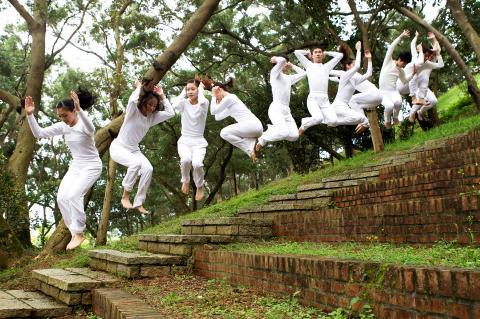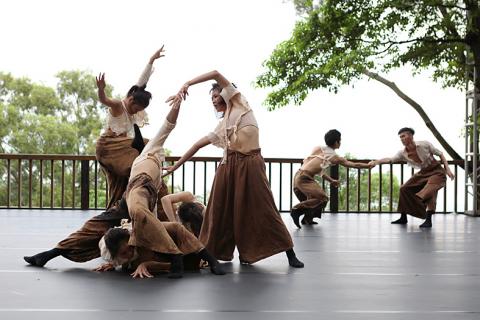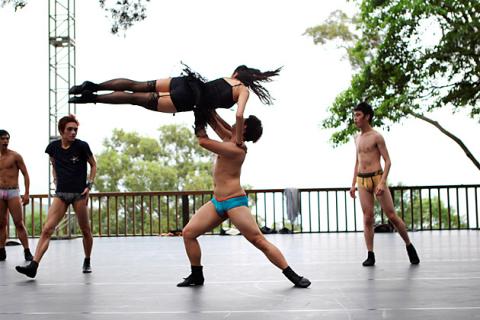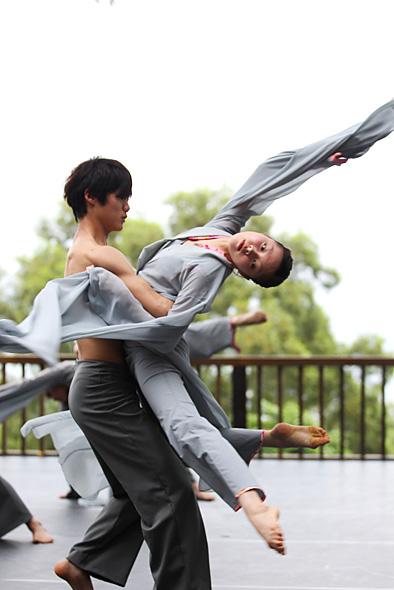If the weather allows it, audiences will get a special treat tonight through Tuesday: watching dancers perform under the stars with the lights of the Taipei City basin as a glittering backdrop.
Taipei National University of the Arts’ School of Dance decided to up the challenge of its annual Summer Dance Concert (北藝大舞蹈學院初夏展演) by holding it in the school’s “Forest Theater” (aka Huang Shan Theater) atop the hill in Kuandu that the campus sits upon.
While it won’t be the first time dance students at the school have performed outdoors — Ping Heng’s (平珩) piece in last fall’s show required the audience to leave the Dance Theater for the walkway outside — this is the first time the dance school has organized an entire open-air performance.

Photo Courtesy of Liu Chen-hsiang
The show’s artistic director, associate professor Ku Ming-shen (古名伸), said the show was a special assignment.
“One very important motivation is that this year is the 100th ROC [Republic of China] anniversary, so I got the assignment to do ‘something special’ … but I didn’t see how I could make it ‘special’ in the indoor theater,” Ku said in a telephone interview late Tuesday night from the stage. “The Forest Theater presents a lot of challenges for the dancers and the production team — a great challenge for the production team since we have to bring everything from power to toilets up here … but I thought if we were going to take this challenge, this was the time to do it.”
It has turned into such a huge undertaking that in addition to the 60 performers, Ku has drafted high-schoolers from the university’s preparatory school and graduate students who don’t usually work on undergraduate shows, even those who are studying dance theory (as opposed to choreography and performance) to help out.

Photo Courtesy of Liu Chen-hsiang
Given the concerns about rain brought by Typhoon Songda skirting Taiwan this weekend, Ku and her team are prepared to move everything indoors — with a few hours notice — and she said a message would be posted on the school’s Web site (www.tnua.edu.tw) to say if the shows will be outdoors or in the Dance Theater. The message will be posted by 6:30pm for evening performances and 1:30pm for the matinees. If Mother Nature forces them to cancel a show entirely, ticket holders will be able to use their tickets at another performance.
There are five works on the program, four by teachers at the school and an early piece by American modern dance icon Trisha Brown, Sololos, which will open the show.
Ku said Sololos was special because Brown’s early work was really focused on crafting the structure of the dance.

Photo Courtesy of Liu Chen-hsiang
“What you see is almost like improvisation; there is a caller who calls the cues and the dancers have to respond. Every performance looks different … you can do it backwards or forwards. It’s a post-modern piece, it creates major combinations that keep evolving,” Ku said.
“The other pieces are by Hugo Fanari and by one of the younger faculty members, Wu Yi-san (吳易珊), and Yang Ming-lung (楊銘隆); people are more familiar with him,” she said.
Yang, who has worked for years with Dance Forum Taipei (舞蹈空間舞蹈團), has created No Trace (無蹤), which will close the show, while Wu’s piece is titled Anti- (岸地).

Photo Courtesy of Liu Chen-hsiang
On his blog, Fanari describes Just Do It, which is set to an eclectic mix of Slipknot, Los Panchos, Philip Glass, Edith Piaf and others, as a “contemporary piece about accepting difference in our society from a human rights perspective” because people judge others on the basis of color, ethnicity, religion, sexual orientation, fashion and diet and a host of other criteria. He wrote that he wants the viewers “to reflect on freedom, human rights, differences and acceptance.”
As for her own piece, May (五月天), Ku said it was created especially for Huang Shan Theater, so the look and feel would be different if they have to perform indoors, adding: “The dancers really interact with the environment.”
“The theater has it’s own challenge, nothing can compare with it,” she said.

May 11 to May 18 The original Taichung Railway Station was long thought to have been completely razed. Opening on May 15, 1905, the one-story wooden structure soon outgrew its purpose and was replaced in 1917 by a grandiose, Western-style station. During construction on the third-generation station in 2017, workers discovered the service pit for the original station’s locomotive depot. A year later, a small wooden building on site was determined by historians to be the first stationmaster’s office, built around 1908. With these findings, the Taichung Railway Station Cultural Park now boasts that it has

Wooden houses wedged between concrete, crumbling brick facades with roofs gaping to the sky, and tiled art deco buildings down narrow alleyways: Taichung Central District’s (中區) aging architecture reveals both the allure and reality of the old downtown. From Indigenous settlement to capital under Qing Dynasty rule through to Japanese colonization, Taichung’s Central District holds a long and layered history. The bygone beauty of its streets once earned it the nickname “Little Kyoto.” Since the late eighties, however, the shifting of economic and government centers westward signaled a gradual decline in the area’s evolving fortunes. With the regeneration of the once

In February of this year the Taipei Times reported on the visit of Lienchiang County Commissioner Wang Chung-ming (王忠銘) of the Chinese Nationalist Party (KMT) and a delegation to a lantern festival in Fuzhou’s Mawei District in Fujian Province. “Today, Mawei and Matsu jointly marked the lantern festival,” Wang was quoted as saying, adding that both sides “being of one people,” is a cause for joy. Wang was passing around a common claim of officials of the People’s Republic of China (PRC) and the PRC’s allies and supporters in Taiwan — KMT and the Taiwan People’s Party — and elsewhere: Taiwan and

Even by the standards of Ukraine’s International Legion, which comprises volunteers from over 55 countries, Han has an unusual backstory. Born in Taichung, he grew up in Costa Rica — then one of Taiwan’s diplomatic allies — where a relative worked for the embassy. After attending an American international high school in San Jose, Costa Rica’s capital, Han — who prefers to use only his given name for OPSEC (operations security) reasons — moved to the US in his teens. He attended Penn State University before returning to Taiwan to work in the semiconductor industry in Kaohsiung, where he